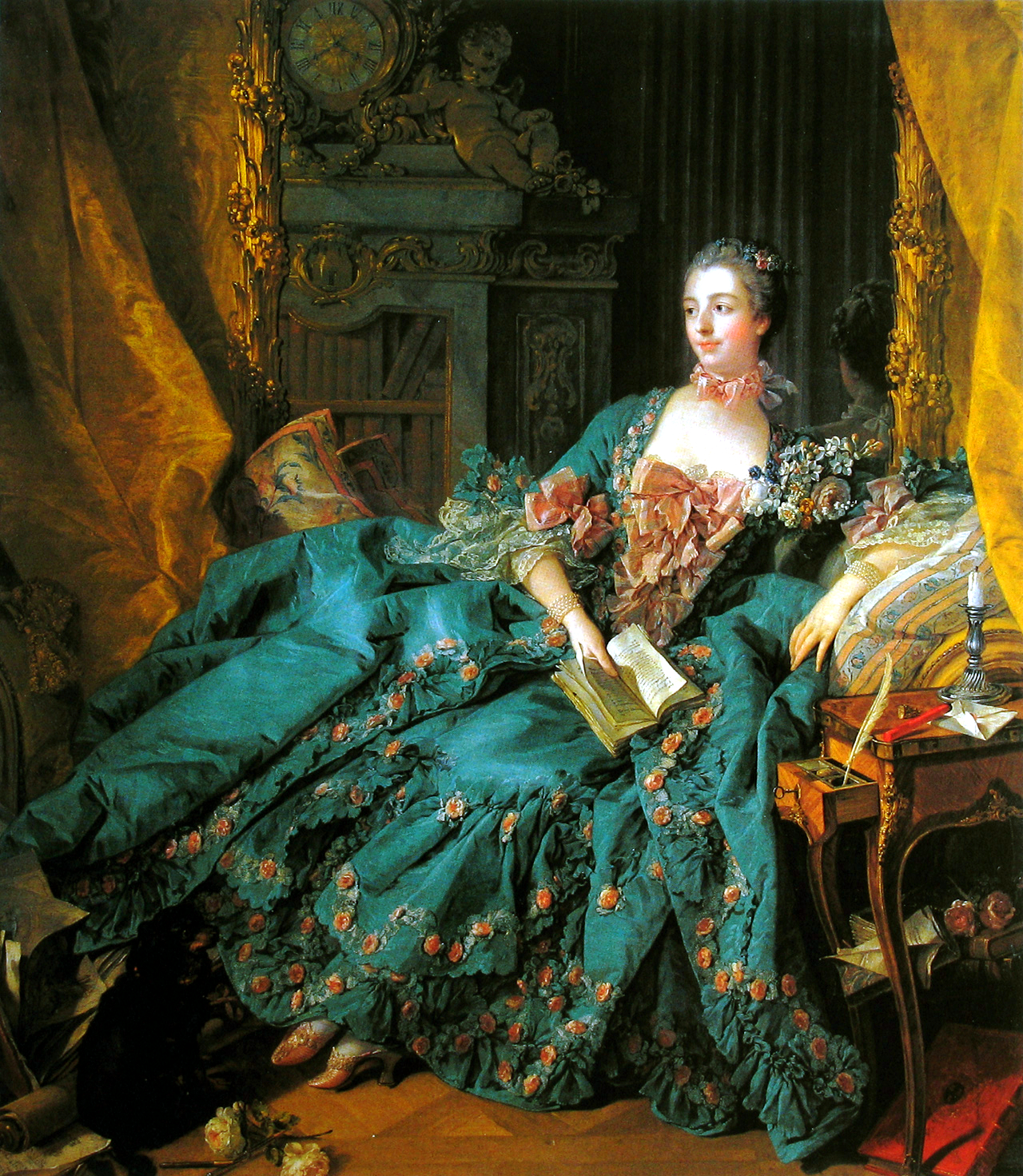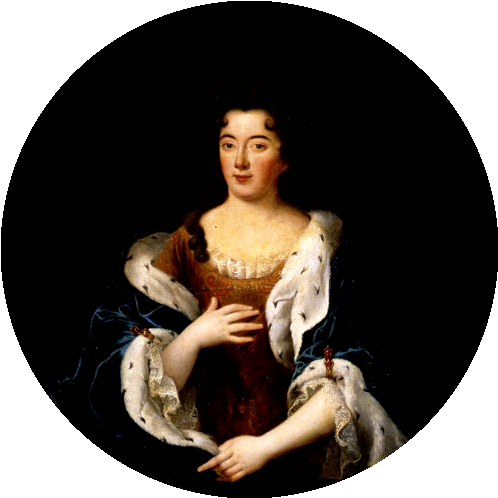While the story of Louis XIV's illegitimate children is well-known and much-discussed, those of his successor have gone fairly unnoticed. I have briefly touched on this subject before in this post but decided to dive a little deeper into unknown family of Louis XV.
None of Louis XV's maîtresses-en-titre gave him children - in fact, he appears to only have had children by women with whom he had brief dalliances with. Whether the mother was known at court or not, the king only ever recognised a single child: Louis Aimé de Bourbon. The reasoning behind this is unclear; perhaps the king had enough in his already large, legitimate family or perhaps he simply lost all interest in the mother once their liaison was over.
While the latter might be true, that would hardly account for why he took such care to marry his children into respectable - albeit anonymous - families. Furthermore, there appears to have been taken pains to provide an official father for the birth certificate - even if this meant listing an entirely fictitious person. In fact, this latter method was not uncommon, especially for women whose husbands were not eager to formally recognise the child.
Also, it is interesting to note that the king appears to have returned to the same women several times - even years apart. Consequently, several of the children listed below have the same mother which suggests that at least a casual relationship existed.
Considering the king's notorious womanizing in a time without birth control, it is hardly surprising that several encounters would result in offspring. It is estimated that the king fathered about 15 children although the exact number cannot be stated with certainty:
 |
| Louis XV |
Charles Emmanuel Marie Magdelon de Vintimille (2 September 1741 - 24 February 1814)
Mother: Pauline Félicité de Mailly, Marquise de Vintimille
Born to the king's mistress, Pauline Félicité, who has become known as the second of the four Nesle-sisters who all became the king's mistress. Pauline Félicité was married to the obliging Marquis de Vintimille who officially recognised the boy as his own - although his time of birth coincides exactly with Pauline's tenure as the king's mistress.
Sadly, Charles' mother died due to complications from his birth. He would then be handed over to his aunt, the Comtesse de Mailly.
Charles was generally considered to the king's son - he was even nicknamed Demi-Louis due to his remarkable resemblance of Louis XV. Perhaps his looks - and his helpful father - was the factor that separated him from his numerous half-siblings; he would have a rather successful career at court during which he was rewarded with both the governorship of Porquerolles and the rank of Maréchal de Camp.
Interestingly, he could have been tied even closer to the king as Madame de Pompadour suggested a match between him and her daughter, Alexandrine Le Normant d'Étiolles. However, Louis would not give his permission and Alexandrine died in childhood. Instead, Charles married Adélaide de Castellane.
Agnès Lucie Auguste (14 April 1761 - 7 April 1826)
Mother: Lucie Madeleine d'Estaing
Ironically, Lucie Madeleine d'Estaing was herself an illegitimate child. She had been born to Magdeleine Erne de Mirfond who had fallen pregnant by the Marquis de Sailhant. She would "serve" as one of the king's unofficial mistresses who were housed in the Parc-aux-Cerfs.
Agnès' parents were listed as Lucie Citoyenne and Louis Auguste before she was entered into the convent of Chaillot where she received an education. The paternity is all-but certain, as Lucie was not married and had no other lover than the king. Also, the king arranged for both Agnès and Aphrodite to be given a convent education.
Mother: Lucie Madeleine d'Estaing
Philippe Louis Marie Innocent Christophe Juste de Narbonne-Lara (28 December 1750 - 10 May 1834) & Louis Marie Jacques Amalric de Narbonne-Lara (23 August 1755 - 17 November 1813)
Mother: Françoise de Châlus, Duchesse de Narbonne-Lara
Benoît Louis Le Duc (7 February 1764 - 1837)
Mother: Jeanne Louise Tiercelin de La Colleterie
Better known as Madame de Bonneval, Jeanne Louise was the king's on-off-again mistress for three years (1762-65). Her story was quite sad; she had become the king's mistress at the age of 16 and was unfortunately persuaded to attempt to entrap Louis XV to recognise Benoît - however, anyone who knew Louis could have told her that forcing his hand was a sure way to find oneself completely in the cold. She was promptly removed from the Parc-aux-Cerfs and taken to the Bastille; she would eventually be released and given 30.000 livres for her services. From then on, she would live somewhat nomadically and took several lovers before dying of cancer at 32.
Benoît's father was stated as Louis Le Duc, an old cavalry official, while the mother was oddly changed to Julie de La Colleterie. The latter appear to be a strange addition as it is not nearly far enough from the actual mother's name to conceal her identity.
Agathe Louise de Saint-Antoine de Saint-André (20 May 1754 - 6 September 1774)
Mother: Marie-Louise O'Murphy
Mother: Marie-Louise O'Murphy
Another child by Morphise who is thought to be the king's, Marguerite was born considerably later than her half-sister - 14 years. By this time, Marie-Louise had been married twice and her second husband officially recognised Marguerite as his own. He was the Comte de Flaghac and thus Marguerite was given her surname. Since her mother had already been married into the lower nobility, Marguerite could also expect a husband of low status (in the eyes of the aristocracy). She was married first to the Comte de Chousy whom she divorced in 1793 (he would be guillotined the following year); secondly, she married Constant Le Normant d'Étiolles - coincidentally a son of Madame de Pompadour's husband.
The hints as to her paternity can once again be found in royal favours. Louis XV made sure that unusually large sums of money were directed towards Marguerite, spending about 350.000 livres on her during her early childhood; more pensions would follow after her father's death. Furthermore, once a husband was found for her the marriage contract was signed in the presence of both the king and queen - something that was otherwise a prerogative of the very highest nobility.
Novembrius de Lionvaux (1761 - 1798)
Mother: Marie-Madelaine de Lionvaux
The only one of the children on this list to be given his mother's name, Novembrius is by far the most anonymous. Little is known of his mother and his own life is almost completely obscure. Yet, it is known that he was sent to live with his uncle, Louis de Lionvaux - he would die without marrying or fathering children of his own.
Amélie Florimond de Norville (11 January 1753 - 27 September 1790)
Mother: Jeanne Perray
Amélie's mother was one of the king's many flings from the up-an-coming bourgeoisie. Her name was Jeanne Perray but her father was named as Louis Florimond de Norville. The problem is that he never existed. Amélie was married off to Ange de Faure who was 41 years old at the time of their wedding while she was 27.
There are certain signs that the king was the father of the young girl. For one, Amélie was given a pension of 2.000 livres from 1772 which was confirmed by Louis XVI when she married. That in itself would be very odd since she does not appear to have worked at court. To further add to this argument is the fact that Louis XVIII also confirmed her descendants' pension.
Mother: Marie Thérèse Françoise Boisselet
Mother: Anne Coppier de Romans, Baronne de Mailly-Coulonge
Louis Aimé had the distinction of being the only illegitimate child to be officially recognised by Louis XV. Unlike most of his half-brothers, he entered the church rather than the army, and became the Abbot of Saint Vincent de Metz before serving as ambassador to Rome. Like his august father, Louis Aimé died of smallpox.
Mother: Marguerite Catherine Haynault
Agnès was also given a fictitious father when her birth certificate was written; hers was stated to be Louis de Montreuil, an old cavalry official. In a rather grotesque twist, she would be married off to Gaspard d'Arod de Montmelas - her mother's own brother-in-law!
Louis XV had arranged for both his daughters by Marguerite to receive an annual income of 24.300 livres; Agnès was also given an official certificate of nobility which allowed her to marry a nobleman - however, hers was only given in 1774 by Louis XVI.
Mother: Marguerite Catherine Haynault
Like her half-sister, Anne Louise was also given a non-existing father on her birth certificate. One might wonder why the same father was not used for both girls but that was not the case. Antoine Louis de la Réale, another "cavalry official" was used for Anne Louise's birth certificate. Having been raised in the convent of Chaillot, she would also receive her certificate of nobility in 1774. She became the Comtesse de Geslin in 1780 but was left behind by her husband when he emigrated during the revolution. Yet, he returned in 1795 upon which he was imprisoned and guillotined. Sadly, five of their six children died during the revolution but the mother was released - widowed and bankrupt.
It was not until the ascension of Louis XVIII that her son would be granted a post and her a pension.
As stated, it is impossible to know exactly how many children the king had out of wedlock. This also mean that there are other children who might just have been the king's children - and as he did not exactly have a habit of officially recognising them, it is a possibility.














